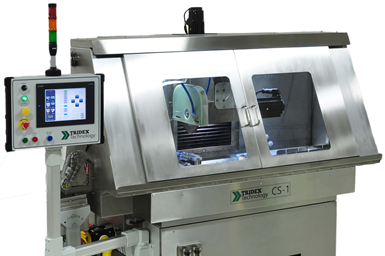Glebar Grinding Machines Combine Operations, Enhance Quality
Glebar’s CS1 Cutoff Machines and TF-9D Thrufeed Grinder reduce the number of operations necessary to complete complex parts, and reduce consumable wear to lower costs.
Share






Glebar CS1 Cutoff Machine
Glebar’s CS1 Cutoff Machines and TF-9D Thrufeed Grinders provide operational simplicity that reduces consumable wear and tear, with the TF-9D also providing light automation capabilities to increase its ease of use for operators.
The company’s CS1-EA Hybrid Burr-Free Electrochemical and Precision Abrasive Cutoff Machine combines the separate functionalities of its CS1-E Burr-Free Electrochemical Cutoff Machine and the CS1-A Precision Abrasive Cutoff Machine. The electrochemical cutoff uses low cutting forces and precision up to .0004” (.01 mm), and completes tasks swiftly — Glebar provides an example of the machine cutting 89 hypotubes 0.020” in diameter in 20 seconds, as opposed to a full three minutes for laser cutting. While the company says electrochemical cutoff prevents burrs, it also provides electrochemical surface grinders for secondary operations like notching, bevel grinds and multi-facet points. The precision abrasive operation’s thin rubber bond cutoff blades limit kerf loss while producing surface roughnesses typically between .4 – .8 μm Ra.

Glebar TF-9D Thrufeed Grinder
Glebar’s TF-9D Thrufeed Grinder uses an 8.675” work wheel, which Glebar says is the widest work wheel on the market. This wheel can grind shapes up to 7.8” on a single pass, and features independently positioned top and bottom slides for enhanced accuracy and reduced setup times. Operators don’t need to constantly mind the machine, either, with the GFS standalone feeding system automating feeding, staging, grinding and unloading.
Related Content
-
How to Determine the Currently Active Work Offset Number
Determining the currently active work offset number is practical when the program zero point is changing between workpieces in a production run.
-
How to Mitigate Chatter to Boost Machining Rates
There are usually better solutions to chatter than just reducing the feed rate. Through vibration analysis, the chatter problem can be solved, enabling much higher metal removal rates, better quality and longer tool life.
-
CNC Machine Shop Honored for Automation, Machine Monitoring
From cobots to machine monitoring, this Top Shop honoree shows that machining technology is about more than the machine tool.













